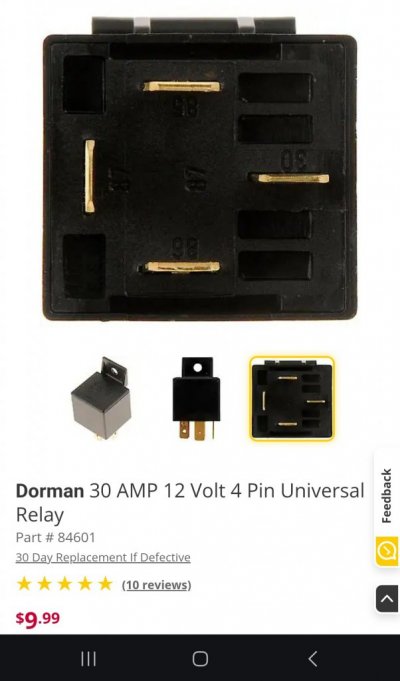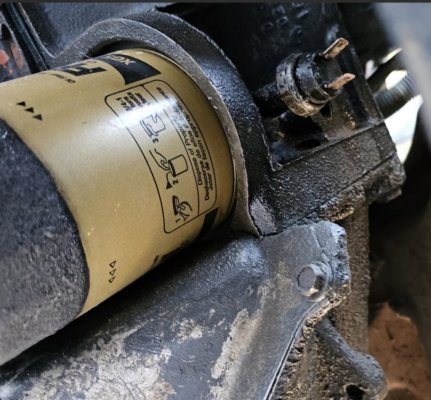Dejure
Full Access Member
- Joined
- Mar 3, 2025
- Posts
- 80
- Reaction score
- 97
- Location
- Eastern Washington
- First Name
- Kelly
- Truck Year
- 1978
- Truck Model
- C15
- Engine Size
- 350
On that 03 Ranger I upgraded to a 78 C15 step side thing, I'm being reminded of how much I've forgotten, and how much more I didn't know and need to learn.
The electrical problems are lessening (Down to about 12, e.g.: (1) Heater motor wire was, probably, cut for a reason; (2) Back up light wires were, probably, cut for a reason too; (3) Connection of the shifter neutral-park safety switch, and back up light connections between the two micro switches on the B&M shifter and the original terminations were beyond previous owners capacities; (4) 12 volts between the negative post and the cable, with every fuse removed is a parasitic drain from God only knows where; (5) wipers working with the key off suggests end-runarounds; (6) 12 volts to the choke 24-7 indicates not the best choices were made; etc.).
The foregoing makes for a lot of rabbit trails. For example, today, I contemplated the choke issue (constant, unfused power versus power from stator or double prong sender).
In the past, I just said to hell with it and installed a manual control. In the 20 to 50 belows of Twisp and Winthrop, Washington, my old 57 and 69 step sides started quicker than did my dad's new cars and trucks.
That manual for automatic choke swap aside, we have that thing called the Net, so I figured I might as well learn about about how chokes work. Man, there is a lot of BS mixed in with fact out there, AND trying to find hard, cold facts takes a lot of rabbit trailing.
For example, we all know a choke should close for cold starts, then open, or be opened, to let more air in as or after the rig warms.
Many, rightfully, point out we are, more often than not, dealing with bi-metal springs that move a lever controlling the choke plate. That bi-metal spring thing even applies to systems in which the carb doesn't have a choke and, instead, the air intake has a devise that opens and closes to enrich or lean the fuel ratio.
I am still in the wondering stages. For example:
(1) There are a lot of discussions about the pro's and con's plates of differing thicknesses and materials under carbs, so the carbs will run cooler, or otherwise perform better.
On the other hand, it's indicated the warming of the engine will alter the positioning of the bimetal choke mounted on the side of a carb. That is, open the choke.
The two bits of information leave me wondering about the effect a thicker plate under a carb has on heating the choke and opening it.
(2) Then there is the often repeated statement, the power for the feed for the choke has to come from a source active when the engine is running. Not just the key in the run position, or the start position, but the engine actually running.
As worded, every time, it's indicated activation of the choke comes with the engine actually running, so, for example, the alternator is active doing its little alternately thing).
Alternately, there is the indication the power needs to come off an oil pressure switch with two terminals, versus just one.
I haven't got to the point of seeing if the sender closes at a certain point, impedance/resistance grows, or there are elf's working on the side (operating a rheostat (only two connections) or potentiometer (ground is there too)).
Thinking on this, I can pull my air cleaner cover, stare at the choke, and it will be wide open, when the engine is cold, As it should be when the engine is warmed.
Suggestions from the component characteristics and circuit configurations suggest power to the bi-metal coil in the choke mechanism will cause it to move the only way left, from open, which is closed, leaving the question of how a warm engine changes anything (opens the choke).
TRANSLATION OF THE FOREGOING: Looking forward to input from individuals more knowledgeable on all things choke than me.
The electrical problems are lessening (Down to about 12, e.g.: (1) Heater motor wire was, probably, cut for a reason; (2) Back up light wires were, probably, cut for a reason too; (3) Connection of the shifter neutral-park safety switch, and back up light connections between the two micro switches on the B&M shifter and the original terminations were beyond previous owners capacities; (4) 12 volts between the negative post and the cable, with every fuse removed is a parasitic drain from God only knows where; (5) wipers working with the key off suggests end-runarounds; (6) 12 volts to the choke 24-7 indicates not the best choices were made; etc.).
The foregoing makes for a lot of rabbit trails. For example, today, I contemplated the choke issue (constant, unfused power versus power from stator or double prong sender).
In the past, I just said to hell with it and installed a manual control. In the 20 to 50 belows of Twisp and Winthrop, Washington, my old 57 and 69 step sides started quicker than did my dad's new cars and trucks.
That manual for automatic choke swap aside, we have that thing called the Net, so I figured I might as well learn about about how chokes work. Man, there is a lot of BS mixed in with fact out there, AND trying to find hard, cold facts takes a lot of rabbit trailing.
For example, we all know a choke should close for cold starts, then open, or be opened, to let more air in as or after the rig warms.
Many, rightfully, point out we are, more often than not, dealing with bi-metal springs that move a lever controlling the choke plate. That bi-metal spring thing even applies to systems in which the carb doesn't have a choke and, instead, the air intake has a devise that opens and closes to enrich or lean the fuel ratio.
I am still in the wondering stages. For example:
(1) There are a lot of discussions about the pro's and con's plates of differing thicknesses and materials under carbs, so the carbs will run cooler, or otherwise perform better.
On the other hand, it's indicated the warming of the engine will alter the positioning of the bimetal choke mounted on the side of a carb. That is, open the choke.
The two bits of information leave me wondering about the effect a thicker plate under a carb has on heating the choke and opening it.
(2) Then there is the often repeated statement, the power for the feed for the choke has to come from a source active when the engine is running. Not just the key in the run position, or the start position, but the engine actually running.
As worded, every time, it's indicated activation of the choke comes with the engine actually running, so, for example, the alternator is active doing its little alternately thing).
Alternately, there is the indication the power needs to come off an oil pressure switch with two terminals, versus just one.
I haven't got to the point of seeing if the sender closes at a certain point, impedance/resistance grows, or there are elf's working on the side (operating a rheostat (only two connections) or potentiometer (ground is there too)).
Thinking on this, I can pull my air cleaner cover, stare at the choke, and it will be wide open, when the engine is cold, As it should be when the engine is warmed.
Suggestions from the component characteristics and circuit configurations suggest power to the bi-metal coil in the choke mechanism will cause it to move the only way left, from open, which is closed, leaving the question of how a warm engine changes anything (opens the choke).
TRANSLATION OF THE FOREGOING: Looking forward to input from individuals more knowledgeable on all things choke than me.



